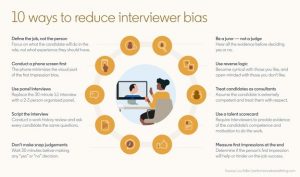Blog
Cognitive biases: Tools and techniques to avoid them (3/3)
In the previous 2 articles on cognitive biases, we have covered the reality and consequences, https://www.jumprecruteurs.ca/blogue/les-biais-cognitifs%e2%80%af-realite-et-consequences-1-3/ as well as identified some of the most common types of bias https://www.jumprecruteurs.ca/blogue/les-differents-types-de-biais-cognitifs-2-3/.
With the participation of Caroline Boyce CRHA, Director of Planning, Acquisition and Integration of Talents at Loto-Québec and lecturer at HEC de Montréal for the Certificate in Human Resources Management, we ruled that biases are human, and that without being negative in itself, can have consequences on the efficiency of a selection process and, ultimately, on a company’s performance.
Now that we are aware of them and can recognize them, how can we avoid them?
By structuring our recruitment process.
This week, we are bringing you some easy-to-use tips.
What are yours?
“You have to be aware of your own biases. You have to accept and become aware of these to be equipped to avoid them “, recommends Caroline.
Evaluate the skills related to the position
By identifying the essential skills of the position to be filled, you will be able to establish from the start precise parameters to guide your selection.
- Limit yourself to a maximum of 7 essential or important skills, to properly target and evaluate these same aspects throughout the process.
- It will then be important to determine selection criteria and to set up an evaluation grid related to these skills.
- An interview outline will then be established, in which questions related to the targeted skills can be prepared for each step of the process.
This way, whoever intervenes, a level playing field for all applicants will be in place.
“Asking about things other than skills can make you legally vulnerable, can affect the candidate’s experience and hinder the selection process,” Caroline emphasizes.
At Jump! we evaluate according to the STAR method (situation, task, action and results) by evaluating the main skills sought by employers, and thus present an objective portrait of the candidates encountered.
Playing devil’s advocate
Caroline shares one of the tools she uses. When she finds herself in a situation where she becomes aware of a cognitive bias (hers or that of a manager), she works to rebalance perception.
If the perception is negative, it asks a positive question related to the skills. For example, in customer service: “Tell me about an experience where you exceeded a customer’s expectations”.
The reverse is also true, in the case of a positive bias! We would ask the following question, for example, “Tell me about a client that you were unable to satisfy” or “What were your biggest challenges during your last job”.
The goal here is to balance our perception to make a factual decision, based on skills and not on first impressions.
Psychometric tests and reference checks
Psychometric tests will validate our perception. They should be used in an organized fashion and ideally between the first and second interview. Aspects to be deepened can thus be addressed during the following meetings.
It is important to confirm that the essential or important skills identified at the very beginning of the process are well mastered by the candidates.
The references can also serve as confirmation if questions specific to the skills to be assessed are asked. For example, if a candidate showed up late for their initial interview, and punctuality is an important element, a question to this effect during the reference check may be asked to validate.
For people with less interview experience: Caroline’s tip
When taking interview notes, separate your sheet in half. On the one hand state the facts, and on the other hand your impressions. During the interview, make sure that every impression has been validated with a fact. At the end of the meeting, be sure to make your decision only with items listed in your “factual” column.
She gives the example of the soft handshake, which gives a perception of lack of leadership. This aspect would therefore be noted on the side of the impressions. A behavioral question should be asked to truly validate the candidate’s leadership skills.
This advice allows you to become aware of your own biases, and to confirm these “certainties” with tangible facts.
In conclusion
It is essential to assess the entire process, and not just one criterion. The decision made on facts, not impressions, will always be the best, for both the employer and the candidates.
For Lou Adler fans – and others who do not know him, I invite you to follow him on LinkedIn – I share with you his 10 ways to reduce cognitive bias in interviews.

Do you want to discuss your talent management strategy that will allow you to maximize your recruitment and retention efforts, and support your growth?
Write to us at info@jumprecruteurs.ca or directly at my address: steeve@jumprecruteurs.ca and we will be happy to discuss and support you through the various stages.
Category
Candidate and Business
Recent articles
Microlearning in Business How to Navigate an Uncertain Job Market in 2025? When Should You Use a Headhunting Firm?Recrutez votre nouveau Talent!
Découvrez les avantages de l'accompagnement de JUMP pour trouver les meilleurs talents.
Trouver le job parfait!
Consulter nos offres d'emplois et faites nous confiance pour vous accompagner vers l'embauche parfaite